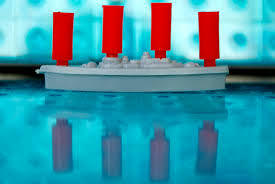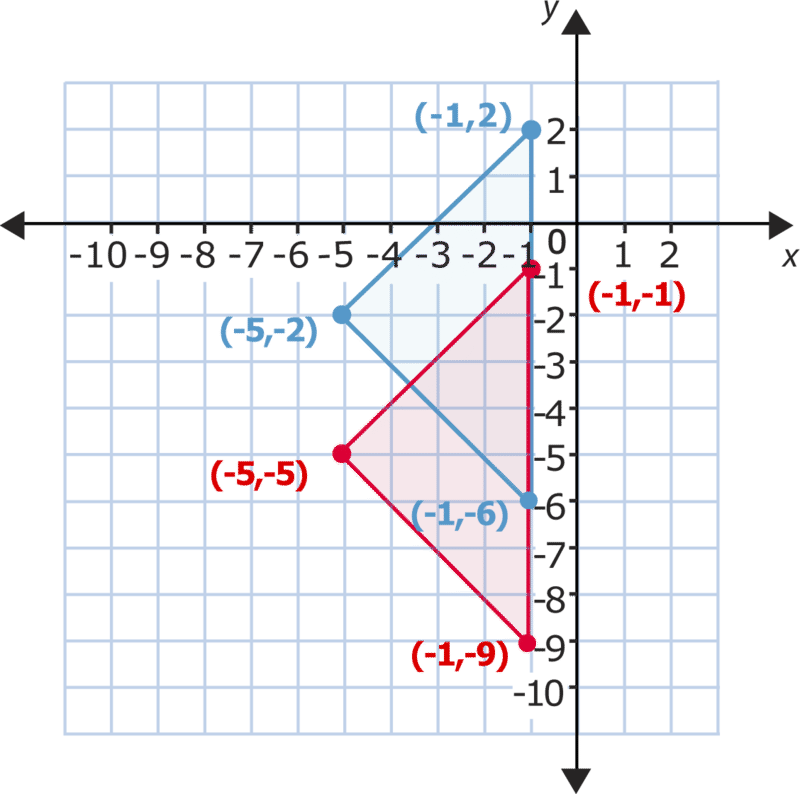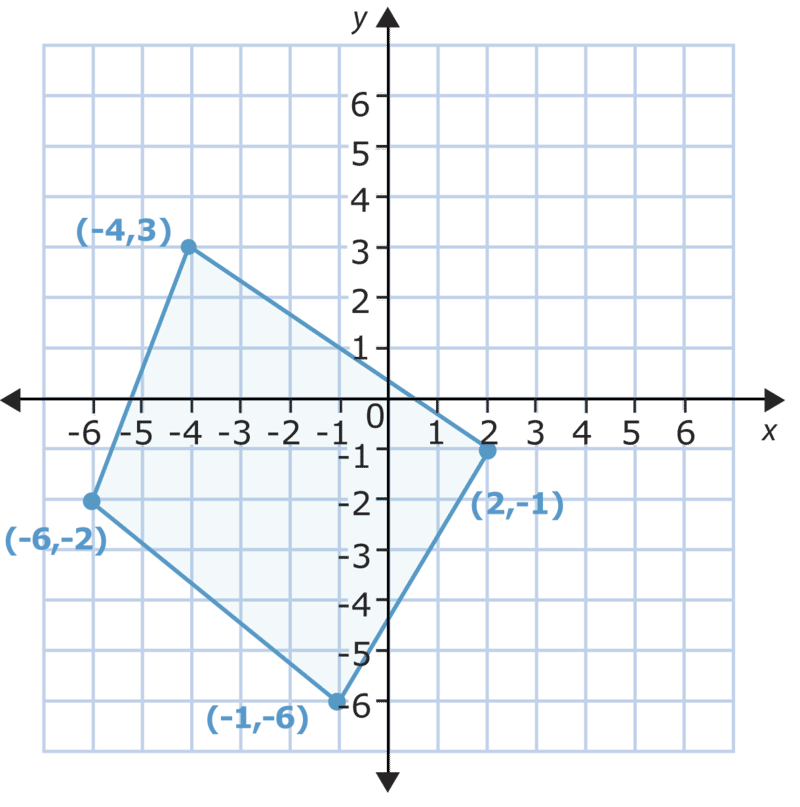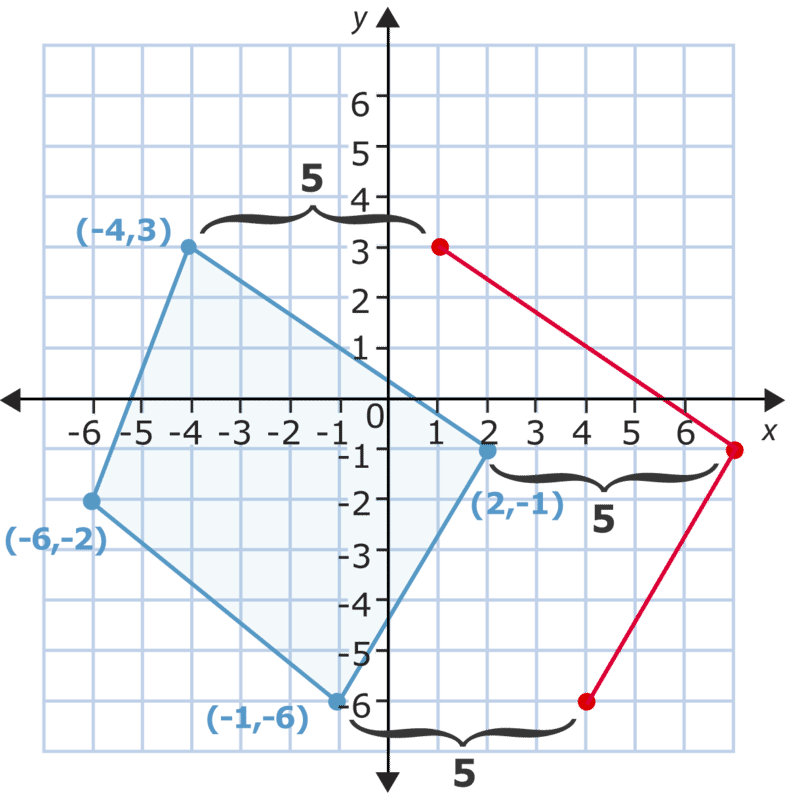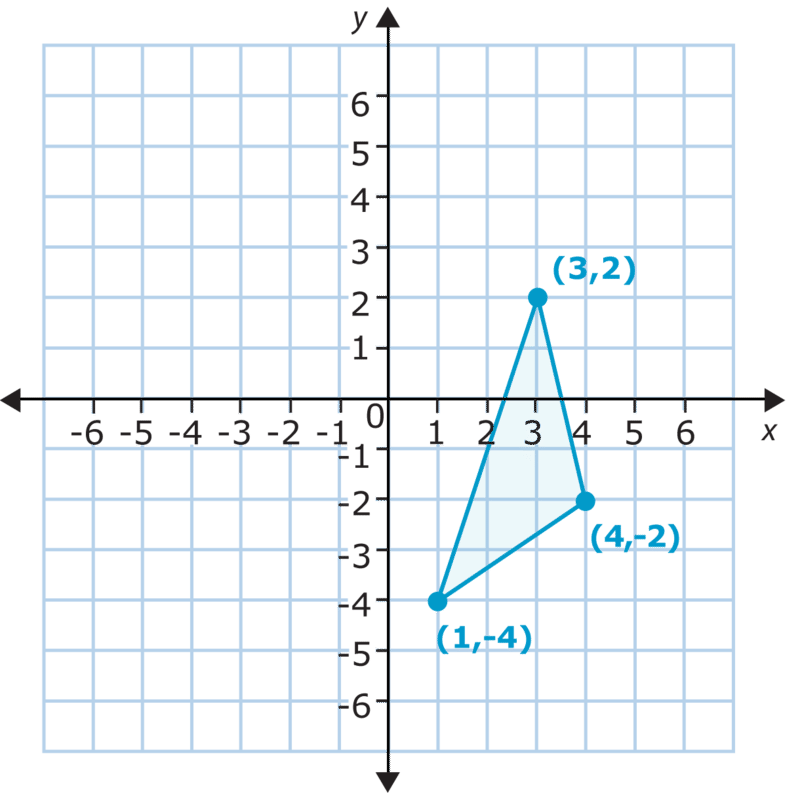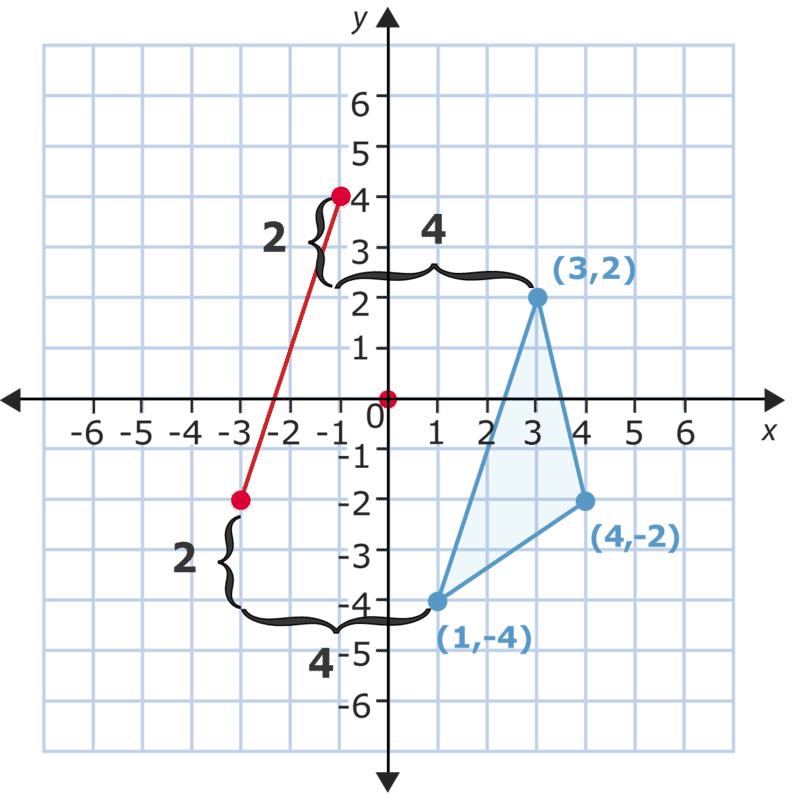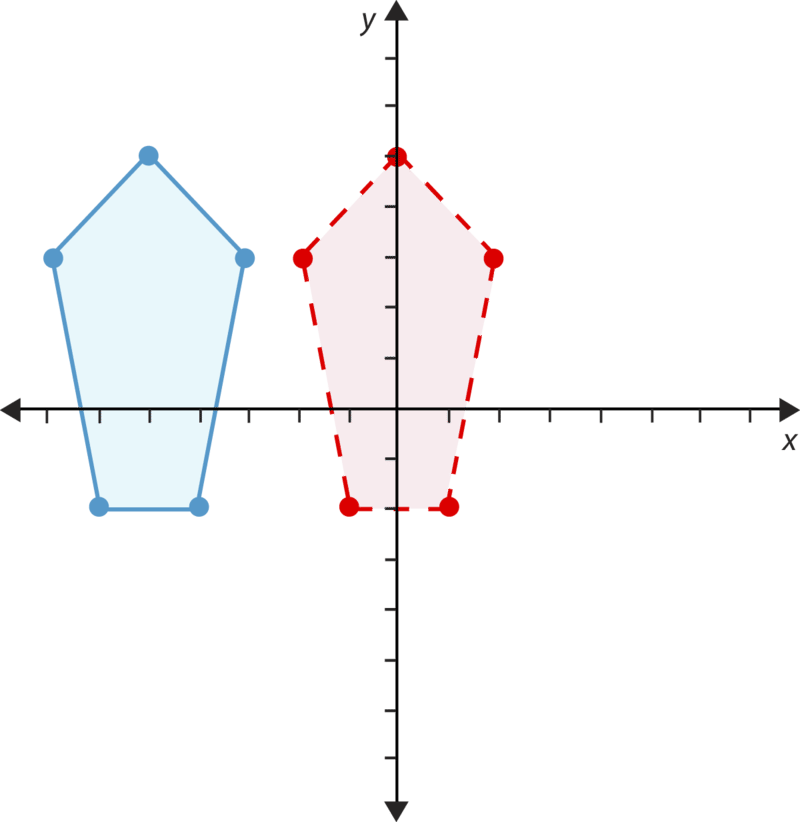8.18 转变分类
章节大纲
-
Mrs. Gilcrest has designed a special version of the game Battleship. Her version requires students to use coordinates such as (1, 2) to guess the location of a ship. The ships are strategically placed so that each is a translation of the other. In order to keep the game easier for the students, she translated the ships the same distance up or down, right or left. If the first ship is at (3, 6), (3, 7), (3, 8) and the second ship is translated 4 units to the right and 4 units up, what are the coordinates of the second ship?
::Gilcrest夫人设计了一个特殊版本的游戏战舰。 她的版本要求学生使用座标, 例如(1, 2) 来猜测船只的位置。 船舶被战略性地安置在位置上, 每个位置都是另一位置的翻译。 为了让学生更容易地玩游戏, 她将船舶翻译在上下、 右或左之间的距离相同。 如果第一艘船在( 3, 6) 、 (3, 7) 、 (3, 8) , 第二艘船将4个座标翻译到右边, 4个座标是第二艘船的座标是什么?In this concept, you will learn how to classify transformations.
::在此概念中,您将学习如何对转换进行分类。Classifying Transformations
::分类转换The coordinate plane is a representation of two-dimensional space . It has a horizontal axis , called the axis, and a vertical axis , called the axis. You can graph and move geometric figures on the coordinate plane.
::坐标平面代表二维空间。它有一个水平轴,称为 X- 轴,和一个垂直轴,称为 y- 轴。您可以在坐标平面上绘制和移动几何数字。Remember the three types of transformations: translation, reflection and rotation .
::记住三种转换类型:翻译、反思和轮换。Now let’s look at performing each type of transformation in the coordinate plane.
::现在让我们来看看协调平面的每种变换情况。When you perform translations, you slide a figure left or right, up or down. This means that on the coordinate plane, the coordinates for the vertices of the figure will change. Take a look at the example below.
::当您进行翻译时,您会向上或向下向左或向右滑动一个图。这意味着在坐标平面上,图顶端的坐标将会改变。请看看下面的例子。Now let’s look at performing a translation or slide of this figure.
::现在让我们来看看这个数字的翻译或幻灯片。You can choose the number of places that you want to move the triangle and the direction that you wish to move it in. If you slide this triangle 3 places down, all of its vertices will shift 3 places down the axis and the coordinate in each pair will decrease by 3.
::您可以选择您想要移动三角形的位数和您想要移动三角形的方向。如果将三角形 3 滑动到下方,所有三角形的顶部都会将 y - 轴向下移 3 位,每对三角形的 Y - 坐标将减少 3 位 。Let’s see why this happens.
::让我们看看为什么会发生这种情况。You can see the change in all of the coordinates. Compare the top points. The coordinate on the left is 2. The coordinate for the corresponding point in the triangle after it moves is -1. The coordinate decreases by 3. Now compare the left-hand point of each triangle. The coordinate originally is -2, and the coordinate after the translation is -5. Again, the difference shows a change of -3 in the coordinate. For the last point, the coordinate starts out as -6, and shifts to -9 after the downward slide. For each point, the coordinate decreases by 3 while the coordinates stay the same.
::您可以看到所有 y - 坐标的更改。 比较顶点。 左侧的 y - 坐标是 2 。 三角形移动后的相应点的 y - 坐标是 - 1 。 y - 坐标减少 3 。 现在比较每个三角形的左手点 。 y - 坐标原来是 - 2 , 翻译后的 y - 坐标是 - 5 。 区别再次显示 y - 坐标的 - 3 变化 。 最后一点, y - 坐标开始为 - 6 , 向下滑动后转为 - 9 。 每点, y - 坐标减少 3 , 而 x 坐标保持不变 。You can translate figures in other ways, too. As you might guess, you move figures right or left on the coordinate grid by their coordinates. You can also move figures diagonally by changing both their and coordinates. One way to recognize translations, then, is to compare their points. The coordinates will all change the same way, and the coordinates will all change the same way.
::您也可以以其他方式翻译数字。 正如您可能猜想的那样, 您可以通过 X - 坐标将数字右移或左移到坐标网中。 您也可以通过修改数字的 x 和 y - 坐标网来对角移动数字。 因此, 识别翻译的一个方法就是比较它们的翻译点。 x - 坐标网会以同样的方式变化, 而 y - 坐标网也会以同样的方式变化 。Here is an example of how to graph a translation.
::以下是如何绘制翻译图的例子。Slide the following figure 5 places to the right.
::向右滑动下图5。In this translation, you will move the figure to the right. That means the coordinates for each point will change but the coordinates will not. You simply count 5 places to the right from each point and make a new point.
::在此翻译中, 您会将数字移到右边 。 这意味着每个点的 x - 坐标会改变, 但 y - 坐标不会改变 。 您只需从每个点向右点数 5 个位数, 然后换个新点 。Once you relocate each point 5 places to the right, you can connect them to make the new figure that shows the translation.
::一旦您将每个点 5 位移到右侧, 您可以将其连接到显示翻译的新数字 。You can check to see if you performed the translation correctly by adding 5 to each coordinate (because you moved to the right) and then checking these against the ordered pairs of the figure you drew. This is called coordinate notation . Notice that each point is represented by coordinates.
::您可以检查您是否正确进行了翻译, 在每个 x - 坐标上添加 5 (因为您移动到右侧) , 然后对照您绘制的图的顺序对进行检查。 这被称为协调符号 。 注意每个点由坐标代表 。These are the points you graphed, so you have performed the translation correctly.
::这些是您绘制的点数, 所以您正确进行了翻译 。Examples
::实例Example 1
::例1Earlier, you were given a problem about Mrs. Gilcrest and her special version of the game Battleship.
::早些时候,你得到一个 Gilcrest 夫人的问题 和她的特殊版本的游戏战舰。She translated the ships the same distance up or down, right or left. If the first ship is at (3, 6), (3, 7), (3, 8) and the second ship is translated 4 units to the right and 4 units up, what are the coordinates of the second ship?
::如果第一艘船在(3,6),(3,7),(3,8),第二艘船向右转4个单元,向上转4个单元,第二艘船的座标是什么?First, remember the signs associated with a move to the right and a move up.
::首先,记住向右移动和向上移动的标志。Right is a move in the positive direction on the axis and up is a move in the positive direction on the axis.
::右是 x - 轴向正方向的移动,上是y - 轴向正方向的移动。Next, add the moves to the coordinates.
::下一步,将移动添加到坐标上。(3+4, 6+4), (3+4, 7+4), (3+4, 8+4)
Then write the new vertices
::然后写下新的顶盘(7, 10), (7, 11), (7, 12)
The coordinates of the second ship are (7, 10), (7, 11), (7, 12).
::第二艘船座标是(7,10),(7,11),(7,12)。Example 2
::例2Solve this problem.
::解决这个问题。Slide the following figure 4 places to the left and 2 places up.
::向左滑动下图 4 位,向左滑动 2 位。First, graph the new points.
::首先,绘制新点图。Graph each point by counting 4 places to the left, and from there 2 places up.
::每个点的图表向左倒数 4 个位数, 从那里往上两个位数。Then, form the new triangle.
::然后组成新的三角形Connect the new points.
::连接新点 。You can check the translation by changing the and coordinates in the ordered pairs and then comparing these to the points you graphed. This time subtract 4 from each coordinate and add 2 to each coordinate. Let’s see what happens.
::您可以通过修改定购对配中的 x 和 y 坐标来检查翻译, 然后将这些坐标与您绘制的点进行比较。 这一次从每个 x 坐标中减去 4 个, 并在每个 y 坐标中增加 2个 。 让我们看看会发生什么 。Example 3
::例3Translate triangle (0, 1), (1, 3), (4, 0) up 4.
::翻译三角ABC (0, 1), (1, 3), (4, 0) 向上 4 。First, remember whether up is a move on the axis or the axis.
::首先,请记住上移是 x - 轴还是 y - 轴。Up is a move on the axis.
::向上是Y - Axis上移的一个动作。Next, add 4 to each of the values.
::接下来,在Y值中各增加4。(0, 1+4), (1, 3+4), (4, 0+4)
Then, write the new vertices.
::然后写出新的顶点(0, 5), (1, 7), (4, 4)
The new triangle has coordinates (0, 5), (1, 7), (4, 4).
::新的三角形有坐标(0,5),(1,7),(4,4)。Example 4
::例4Translate triangle (-3, 2),(1, 6),(2, 1) down 2.
::翻译三角DEF( 3, 2), (1, 6), (2, 1) , 将三角DEF( 3, 2) 翻译为 2 。First, remember whether down is a move on the axis or the axis.
::首先,请记住下移是 x - 轴还是 y - 轴。Down is a move on the axis.
::向下是Y - 轴的动作。Next, subtract 2 from each of the values.
::接下来,从每个 Y - 值中减去 2 。(-3, 2-2), (1, 6-2), (2, 1-2)
Then, write the new vertices.
::然后写出新的顶点(-3, 0), (1, 4), (2, -1)
The new triangle has coordinates (-3, 0), (1, 4), (2, -1)
::新三角形有坐标( 3, 3, 0, 1, 4, 2, 1)Example 5
::例5Translate triangle (-5, 4), (1, 8), (3, 5) to the right 3.
::将三角 XYZ( 5, 4), 1, 8), (3, 5) 向右3 翻译为三角 XYZ( 5, 4) , (1, 8) , (3, 5) 。First, remember whether right is a move on the axis or the axis.
::首先,请记住正确的是 x - 轴还是 y - 轴的动作 。Right is a move on the axis.
::右键是 X - 轴的动作 。Next, add 3 to each value.
::下一步,在每个x-价值中增加3个。(-5+3, 4), (1+3, 8), (3+3, 5)
Then write the new vertices
::然后写下新的顶盘(-2, 4), (4, 8), (6, 5)
The new triangle has coordinates (-2, 4), (4, 8), (6, 5).
::新的三角形有坐标( 2, 4, 4, 8), (6, 5)。Review
::回顾Identify the transformations shown below as a translation, reflection, or rotation.
::标明下列翻译、反思或轮换的变换。-
True or false. This figure has been translated 5 places to the right.
::这个数字被译为右边5个地方。
Translate each figure to the right 6 places and up 1. Then write the new coordinates for the figure.
::将每个数字转换为正确的 6 位数和1 上方 1 。 然后写出图的新坐标 。-
Triangle
(-1, 2)(1, 6)(2, 1)
::三角DEF(-1, 2)(1、2, 1, 6)(2, 2, 1) -
Triangle
(-3, 2)(1, 6)(2, 1)
::DEF三角(-3,2)(1、2,1,6)(2,1) -
Triangle
(0, 2)(1, 6)(2, 1)
::三角三角DEF(0, 2)(1, 6)(2, 1) -
Triangle
(4, -2)(1, 6)(2, 1)
::三角三角DEF(4,2)(1,6)(2,1) -
Triangle
(5, 3)(1, 6)(2, 1)
::三角DEF(5, 3)(1, 6)(2, 1)) -
Triangle
(4, 4)(1, 6)(2, 1)
::三角三角DEF(4,4,4)(1,6)(2,2,1)
Review (Answers)
::回顾(答复)Click to see the answer key or go to the Table of Contents and click on the Answer Key under the 'Other Versions' option.
::单击可查看答题键, 或转到目录中, 单击“ 其他版本” 选项下的答题键 。Resources
::资源 -
True or false. This figure has been translated 5 places to the right.
